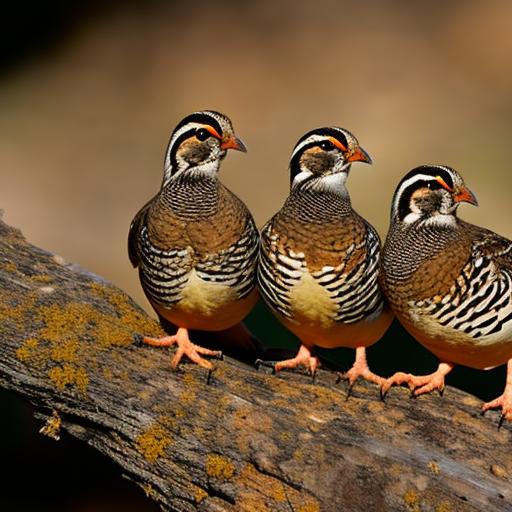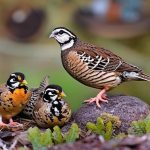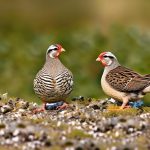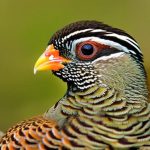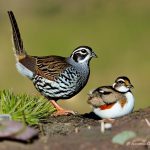Male quails, also known as cocks, are small game birds that are popular for their meat and eggs. They are known for their distinctive calls and are often kept in backyard farms or commercial poultry operations. Male quails are social birds that thrive in the company of other quails, but they can also exhibit aggressive behavior, especially towards other males. Understanding the behavior and needs of male quails is essential for keeping them healthy and happy in a domestic setting. This article will provide an in-depth look at male quail behavior, their living environment, nutrition, aggression management, and health monitoring to help quail owners create a suitable and harmonious environment for their birds.
Key Takeaways
- Male quails are social birds that thrive in small groups
- Male quails exhibit various behaviors such as dust bathing and mating displays
- A suitable living environment for male quails includes spacious cages and hiding spots
- Male quails require a balanced diet of seeds, greens, and protein
- Aggression and dominance among male quails can be managed through proper space and enrichment
Understanding Male Quail Behavior
Male quails are known for their social nature and tend to thrive in the company of other quails. They are highly territorial birds and can exhibit aggressive behavior, especially during the breeding season. Male quails will often engage in dominance displays, such as puffing up their feathers, vocalizing loudly, and engaging in physical fights with other males to establish their position within the group. It is important to understand that aggression is a natural behavior for male quails, but it can be managed through proper housing and social dynamics. Additionally, male quails are known for their distinctive calls, which they use to communicate with other quails and establish their territory. Understanding these behaviors is crucial for creating a suitable living environment for male quails.
Male quails also exhibit courtship behavior towards female quails, including performing elaborate displays such as strutting, wing-fluttering, and vocalizing to attract a mate. Understanding these behaviors can help quail owners provide an environment that supports natural mating and breeding behaviors. By understanding the social dynamics and behaviors of male quails, owners can create a living environment that minimizes stress and aggression, leading to healthier and happier birds.
Creating a Suitable Living Environment for Male Quails
Creating a suitable living environment for male quails is essential for their well-being and overall health. Male quails require adequate space to move around and establish their territories without feeling overcrowded or stressed. When housing male quails together, it is important to provide at least 1 square foot of space per bird to prevent overcrowding and reduce the likelihood of aggressive behavior. Additionally, providing hiding spots such as shrubs, logs, or small shelters within the enclosure can help reduce stress and provide a sense of security for the birds.
The housing should also include areas for dust bathing, as male quails will often engage in this natural behavior to keep their feathers clean and free from parasites. Providing a shallow tray filled with sand or dusting powder will allow the quails to engage in this natural behavior, promoting good hygiene and overall well-being. Furthermore, the housing should be well-ventilated to ensure good air quality and prevent respiratory issues. By creating a suitable living environment that meets the social and behavioral needs of male quails, owners can minimize stress and aggression among their birds.
Providing Adequate Nutrition for Male Quails
Proper nutrition is essential for the health and well-being of male quails. A balanced diet should include a high-quality commercial quail feed that is specifically formulated for game birds. The feed should contain a mix of grains, seeds, and essential nutrients such as protein, vitamins, and minerals to support the nutritional needs of male quails. Additionally, providing access to clean water at all times is crucial for hydration and overall health.
In addition to commercial feed, male quails can also benefit from supplemental treats such as mealworms, fruits, and vegetables to provide variety in their diet. These treats can be offered in moderation to prevent overfeeding and ensure that the quails receive all the essential nutrients from their primary feed. It is important to monitor the quails’ food intake and adjust their diet as needed based on their activity level, age, and overall health. By providing adequate nutrition, quail owners can support the health and vitality of male quails in their care.
Managing Aggression and Dominance Among Male Quails
Aggression and dominance are natural behaviors exhibited by male quails, especially during the breeding season. However, it is important for quail owners to manage these behaviors to prevent injuries and maintain a harmonious living environment for their birds. One effective strategy for managing aggression among male quails is to provide multiple feeding and watering stations within the enclosure. This allows the birds to access food and water without competing with each other, reducing the likelihood of aggressive encounters.
Additionally, providing ample space within the enclosure can help minimize territorial disputes among male quails. Ensuring that the housing is large enough to accommodate the birds’ natural behaviors, such as dust bathing and foraging, can help reduce stress and aggression. It is also important to monitor the birds for signs of aggression, such as excessive pecking or chasing, and intervene if necessary to prevent injuries.
Introducing new birds into an established group of male quails should be done with caution to prevent aggressive behavior. Gradually introducing new birds to the group while closely monitoring their interactions can help minimize stress and aggression during the integration process. By managing aggression and dominance among male quails, owners can create a peaceful living environment that supports the well-being of their birds.
Monitoring the Health and Well-being of Male Quails

Monitoring the health and well-being of male quails is essential for early detection of any potential issues or illnesses. Regular health checks should include observing the birds for any signs of illness or injury, such as lethargy, loss of appetite, abnormal droppings, or changes in behavior. Additionally, maintaining a clean living environment by regularly cleaning the housing and providing fresh bedding can help prevent the spread of diseases and parasites.
It is also important to provide regular veterinary care for male quails to ensure that they receive necessary vaccinations and treatments for common poultry diseases. Working with a veterinarian who has experience with poultry can help ensure that the birds receive proper care and treatment when needed. Furthermore, providing a balanced diet and access to clean water at all times is crucial for supporting the overall health of male quails.
Quail owners should also be mindful of environmental factors that can impact the health of their birds, such as extreme temperatures or exposure to predators. Providing adequate shelter from harsh weather conditions and securing the enclosure from potential predators can help protect the well-being of male quails. By monitoring the health and well-being of male quails on a regular basis, owners can identify any potential issues early on and take appropriate measures to ensure the health of their birds.
Conclusion and Final Tips for Keeping Male Quails Together
In conclusion, understanding the behavior, housing needs, nutrition, aggression management, and health monitoring of male quails is essential for creating a suitable living environment for these social birds. By providing adequate space, hiding spots, dust bathing areas, and well-ventilated housing, owners can support the natural behaviors of male quails while minimizing stress and aggression. Additionally, providing a balanced diet with access to clean water and supplemental treats can support the nutritional needs of male quails.
Managing aggression and dominance among male quails through multiple feeding stations, ample space within the enclosure, and careful introduction of new birds can help create a harmonious living environment. Regular monitoring of the health and well-being of male quails is crucial for early detection of any potential issues or illnesses. By working closely with a veterinarian who has experience with poultry and providing proper care and attention to their needs, owners can ensure that their male quails thrive in a domestic setting.
In conclusion, keeping male quails together requires careful consideration of their social dynamics, housing needs, nutrition, aggression management, and health monitoring. By understanding these key aspects of caring for male quails, owners can create a suitable living environment that supports the natural behaviors and well-being of their birds.
If you’re considering keeping male quails together, it’s important to provide them with adequate space and a suitable environment. You may find the article on “how big does a coop need to be for a chicken” from Poultry Wizard helpful in understanding the space requirements for housing male quails. Proper planning and design are crucial when creating a living space for your quails, and this article offers valuable insights into coop size considerations. Check it out here.
FAQs
What is the best way to keep male quails together?
The best way to keep male quails together is to provide enough space for each bird, as overcrowding can lead to aggression. It is also important to provide hiding spots and places for the quails to establish their own territories.
What should I feed male quails when keeping them together?
Male quails should be fed a balanced diet that includes a high-quality game bird feed, as well as access to grit and fresh water. It is important to monitor their food intake to ensure they are not overeating or undernourished.
How can I prevent aggression when keeping male quails together?
To prevent aggression when keeping male quails together, it is important to provide enough space, hiding spots, and places for the quails to establish their own territories. Additionally, providing distractions such as toys or foraging opportunities can help reduce aggression.
What are the signs of aggression in male quails?
Signs of aggression in male quails can include pecking, chasing, and fighting. It is important to monitor the birds for any signs of aggression and take steps to reduce it, such as providing more space or separating aggressive birds.
Are there any specific housing requirements for keeping male quails together?
When keeping male quails together, it is important to provide a spacious and well-ventilated coop or aviary with plenty of hiding spots and perches. The housing should also be secure to protect the quails from predators.
Meet Walter, the feathered-friend fanatic of Florida! Nestled in the sunshine state, Walter struts through life with his feathered companions, clucking his way to happiness. With a coop that’s fancier than a five-star hotel, he’s the Don Juan of the chicken world. When he’s not teaching his hens to do the cha-cha, you’ll find him in a heated debate with his prized rooster, Sir Clucks-a-Lot. Walter’s poultry passion is no yolk; he’s the sunny-side-up guy you never knew you needed in your flock of friends!

